A Heaving Line is perfect for weighting the end of a throwing line. It’s also faster to tie and lighter than the Monkey’s Fist. Today Bryan demonstrates the method for tying a Heaving Line and shows how it fits into our almost-complete DIY Knot Board Display.
Heaving Line » Stopper Knots
(Strength: 4/Security: 4/Stability: 3/Difficulty: 2) See below for what these ratings mean.
For either method of tying, the Sheepshank should only be tied with static rope and never dynamic. Keep in mind that many people consider the hastier version tied in the video to be less secure and stable.
Ratings
Strength/Security/Stability/Difficulty
Each knot will be assigned a rating from 1-5 (1 representing the lowest score) based on the following four properties:
Strength – All knots will weaken the strength of a rope, however, there are knots that are stronger than others. The scale here will reflect how strong the rope remains with the specified knot.
Security – The security scale refers to how well the knot will stay tied, and resist coming loose under a normal load.
Stability – Stability refers to how easily the knot will come untied under an abnormal load (i.e. the knot being pulled in a direction it was not intended to) A lower score here represents instability.
Difficulty – The lower the number, the easier a knot is to tie.

